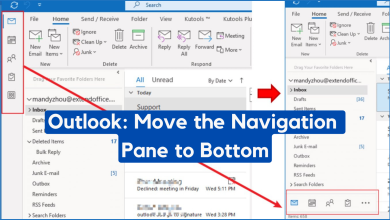How to Fix “Outlook Out of Memory or System Resources” Error?
Microsoft Outlook error message: “Outlook Out of Memory or System Resources” usually indicates a problem with memory management, meaning that the service does not have enough resources to perform an operation or open a folder.

Table of Contents
1. Close Background Programs
On PCs with insufficient memory capacity or when programs use more resources than are available, it is recommended to close background applications to free up resources. Sometimes, certain apps or services running in the background can consume a large portion of the available memory resources.

2. Adjust the Paging File Size
When your computer does not have enough memory to run certain applications simultaneously, you can set a portion of your disk drive as “virtual memory.” This essentially creates an “overflow area” where applications can use the space whenever the data exceeds the installed memory capacity.
- Open the Windows Start menu and type “View advanced system settings.”
- Under the “Advanced” tab, you’ll see a “Performance” section. Click on the “Settings” button in front of it.

Open System Properties, and go to “Advanced.” - In the “Performance Options” dialog that pops up, select “Advanced” and under “Virtual memory,” click the “Change” button.

Under “Performance Options,” go to “Virtual memory.” - Uncheck “Automatically manage paging file size for all drives.”
- Under “Space available,” check the “Custom size” option.

Choose a custom paging file size. - Calculate 1.5% of your total RAM available (in MBs) and enter that in the field provided.
- Restart your computer for the changes to take effect.
3. Run the System File Checker (SFC)
Although extremely rare, your system may have a corrupt Windows file. SFC scans your computer and looks for such files. If found, it tries to repair and resolve the issue. Outlook may be in conflict or have a corrupted file that leads to frequent crashing.
- From your desktop, press the Windows + X key combination.
- From the list that appears from your taskbar, choose Terminal (Admin).

From the menu that pops up, choose “Terminal (Admin).” - On the User Account Control (UAC) prompt, click “Yes.”
- In the terminal, type “sfc /scannow” and press Enter.
- The process will start, and SFC will examine your system files.

SFC will start examining your system files. - Once complete, try restarting Outlook to see if the issue persists.
4. Clear OST Files
If your mailbox has become too large, you may be running into storage issues. This may lead to unexpected problems and potentially prevent you from updating Outlook as well. Over time, you may have to delete an OST file if it’s consuming a lot of storage space since it may be hitting the maximum possible mailbox size.
Since an OST file is more or less a cache for mailbox content, it can be deleted without losing access to your data. It is essentially recreated, syncing the data with the current status of your mailbox.
- Press the Windows key + R to open the Run dialog.
- Type %localappdata%\Microsoft\Outlook and hit Enter.

Accessing the Microsoft Outlook directory. - Locate the OST files within the Outlook folder that opens, right-click them, and select Delete.

Deleting OST Files from within Outlook’s main directory.
5. Repair Microsoft Office
In some cases, the error is caused by issues specific to a machine or user. In such cases, a simple repair or reinstalling of the application entirely can potentially clear out any bugs. If Microsoft Office itself is corrupt or damaged, you may encounter frequent crashes when using Outlook.
- Open the Control Panel, select Programs, and then click on “Uninstall a program.”
- Find Microsoft Office on the list and click Change.

Choose Microsoft Office from the list of programs. - Choose “Quick Repair” and click on “Repair.”

Choose “Quick Repair.” - Complete the repair process by following the on-screen instructions.
- Once finished, a message stating “Done Repair” should appear on the screen.





